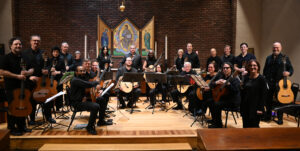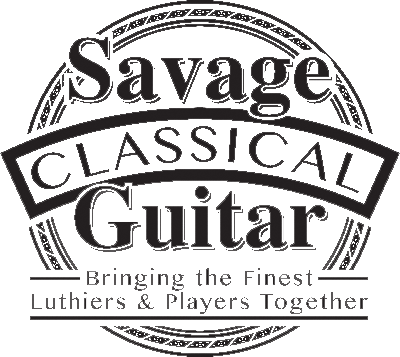by Mark Greenberg
March 2006
Paul Smith
Mannes College of Music
December 20, 2005
I
Presented for your consideration, one Paul Michael Smith, Mannes guitar major. When first seen as a first year student several years ago, he impressed as a perfectly competent young player. If anything, I mistook him (sometimes literally) for a smaller, less technically advanced version of Brett Williams, who is both larger physically and eight years older.
Of course, such impressions are always incorrect. No one is really like anyone else. I hope Brett and Paul will forgive this analogy, but my wife keeps Budgies. Though they are only birds, with careful observation each of the dozen or so that we have owned displayed very definite personalities. I daresay if you observed a thousand budgies patiently enough, the case would be the same. May we not claim as much for guitarists?
How to describe Paul’s particular course? Why do the two seem so different to me now, several years later?
Though I have little or no interest in baseball, a pre-seasonal sports analogy comes to mind. In fact, Brett Williams reminds me more of a slugger. He’s in your face. He confronts the audience.
Says: “Yo! I AM Brett Williams. See this Piazzolla Tango? I’m gonna hit it waaaay out there…” Gestures towards the Mannes’ left field bleachers.
And so he does. Now he has gotten together with Giacomo La Vita and formed a duo of spectacular energy and technical resource. Together they make up the musical Mantle and Marris of Mannes. (How’s that for alliteration? You want better? Try that heavyweight hitter, Homer.)
Paul Smith, on the other hand, is more of a utility fielder. He can hit all right, but he can cover first, play shortstop, third, what the heck? Hey, in a pinch he can pitch. He showed his versatility at two remarkable Mannes recitals, both of which were constructed around an exquisite new chamber piece by Terry Champlin, The Bells of Star Island.
The Guitar Ensemble concert this year was perhaps less spectacular than last year’s production: no harp this time. Yet, though this article is about Paul, I would be criminally negligent in not mentioning the lovely performance of three Dowland songs by Kurt Toriello and Kate Emmerman, whose pure and accurate soprano served this music perfectly. But back to Paul Smith, who closed the first half of the program by playing continuo for a baroque Concerto for Mandolin, 2 Violins and Basso directly from the score. See? What did I tell you? He can cover centerfield without breaking a sweat.
II
At this point, I suppose I should now proceed directly to discussing Paul’s own recital and describe how the soloist occupied himself on the stage and what a hotshot guitarist he is and all that stuff. And he is. He is pretty hotshot. And I do intend to do all that stuff. I really do. But first I want to pull back and take a look at a much larger field. I think it’s more important to discuss how such recitals come to be, and what forces stretched and shaped Paul into such a versatile and interesting player.
Which leads us to pull back even further from centerfield and into the very large question of How Art is Made, and in particular, the why and wherefore of Terry Champlin’s lovely and interesting new piece.
First, one must proclaim loudly that “Art is not made in a Vacuum,” meaning that artists are susceptible to the forces of the real world.
But beyond this, Art is also not made in an Ocean, meaning that an artist, even an artist such as Mozart or Bach, works within the very particular situation and material at hand. In the case of Mozart, I would refer you to Maynard Solomon’s very fine biography for specifics of how this clarinet concerto, or that horn concerto, came to be based on the very particular strengths of very particular players for whom they were intended.
Nor is the situation at all unique to music. Michaelangelo’s David no doubt owes much of its form to the block of marble from which it was carved. And a delightful exposition of this in the theatre may be found in the film Shakespeare in Love.
All this is to say that Terry Champlin’s piece, The Bells of Star Island, manages to create a sonic world that both does and does not feature the guitar as the Star of Star Island. It is a perfect vehicle for Paul, as well as a masterpiece of writing for the guitar (albeit a modestly amplified guitar) as holding its own amongst the other, more quotidian chamber instruments.
In closing this section, let me add a few more words about Terry. I would not exactly say he is a born composer. Actually, he is more of a born scientist and started out as a physicist. But it is easy to understand why he went into music. Frankly, he is a highly emotional human being who probably could have never found science entirely suitable for direct emotional expression. Still, as a musician, he remains extremely analytical in approaching specific pieces of music, and uses the scientific method of empirical experimentation; i.e., he rewrites and rewrites until it works.
And if there is one thing that Terry knows, it’s what does and does not work. Here, he wound up using amplification and integrating the guitar part more deeply into the fabric and texture of the piece, an ideal situation for a player such as Paul, who is far happier at shagging melodic lines than standing alone onstage, eternally at bat.
III
Which brings us to the night of December 20, 2005. And where were you on the night of December 20, 2005 at 8:00 PM? If you weren’t at Paul Smith’s recital, that is understandable because the New York transit strike was at its height (or do I mean its depths?) at that time.
Me? Through a series of misadventures, I guess I managed to show up around twenty, thirty minutes late, thereby missing Spirit of Trees, an Alan Hovhaness work for harp and guitar. By the time I put in an appearance, the harp was being wheeled off to the dugout.
We caught up with Paul Smith (as they say in the trade) in time for a new solo work, Variations for Guitar, by the young composer Raphael Fusco (b. 1984). Paul, like many other young players, came to classical guitar by way of rock and jazz. Thus, the idiom of this piece was very much within his range and temperament. Here Paul was center-stage, and yet maybe not, for (like all excellent musicians) he deferred to the music itself and the composer’s swinging intent through a series of progressions and developments.
The first half of the program concluded with a Duo (marked down from Trio) by Vivaldi. The original was largely for lute and continuo, with a gratuitous part for violin later added by Vivaldi (and much later again removed by Paul). With the aforementioned composer at the keyboard (I mean Fusco, not Vivaldi), Paul got a chance to field full and splendid melodic lines. To this piece, both players brought fine spirit and gusto (as they say in the trade).
The second half of the program opened with Robert Cuckson’s Capriccio for Guitar. This is a tremendously challenging work by a brilliant composer who writes well but not idiomatically for the guitar. The main problem here is voice leading, with continuity over the fingerboard posing a major artistic and technical challenge. Paul did an admirable job meeting this challenge — a testament to a great deal of very hard work in both preparation and musical empathy.
The program concluded with Terry Champlin’s important new work for string quartet and guitar. The piece is built in three movements (marked down from four, but by Terry, not Paul!), that perfectly integrate the guitar. The opening movement is a Schubertian landler-like rondo allegretto. Here, guitar is by no means soloist, but rather in pitch and toss with the other instruments. In the middle movement, a chorale in 5/4 is built around a theme similar in flavor to Hovhaness. Only in the last movement, a beautifully atmospheric finale that gives title to the piece, does the guitar come into its own and have the final say. Ravishing harmonics, like bells heard through fog, bring this lovely new work to a deeply satisfying conclusion.
Home run with the bases loaded. All five players scored.









